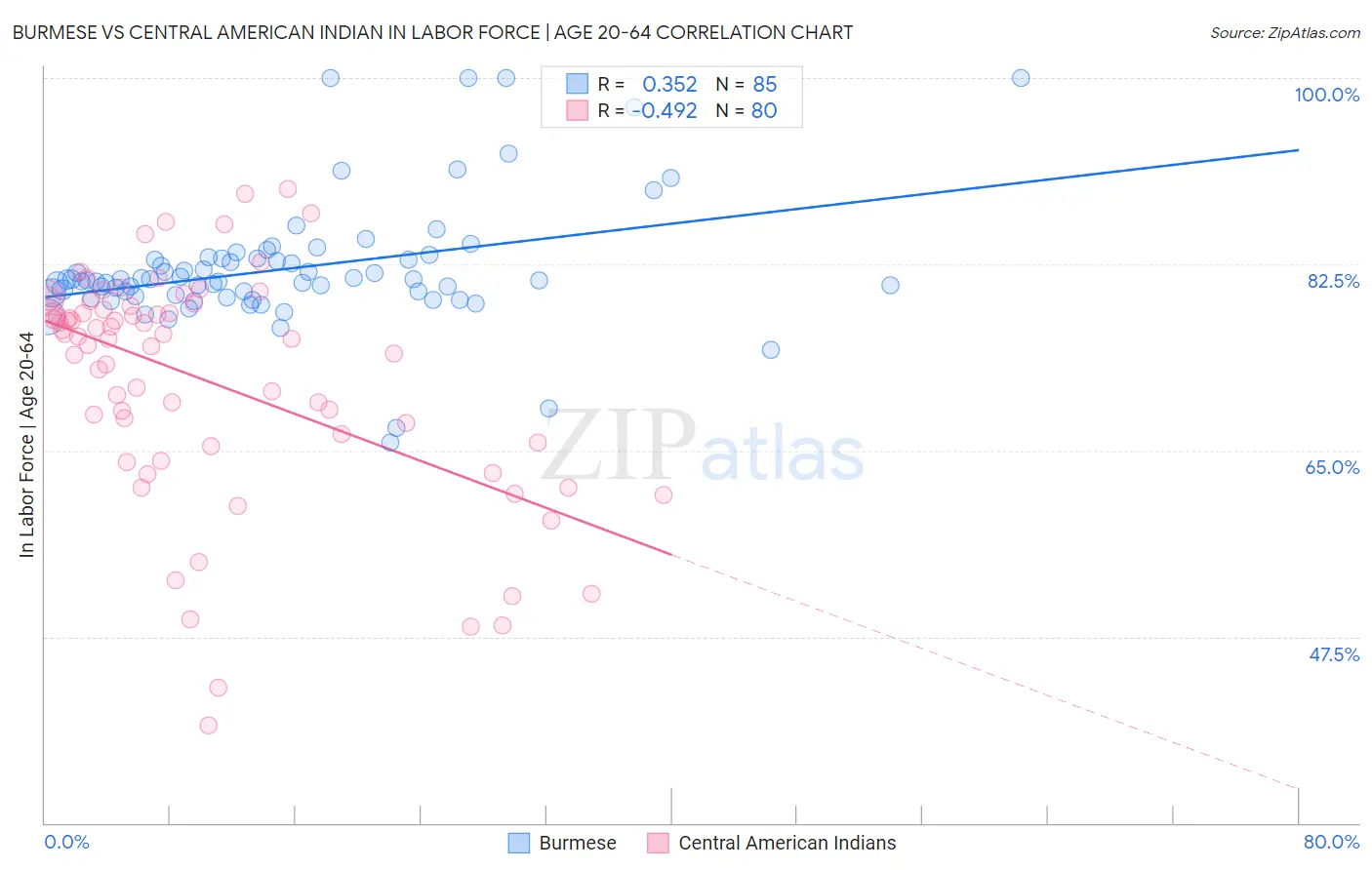Burmese vs Central American Indian In Labor Force | Age 20-64
COMPARE
Burmese
Central American Indian
In Labor Force | Age 20-64
In Labor Force | Age 20-64 Comparison
Burmese
Central American Indians
80.3%
IN LABOR FORCE | AGE 20-64
98.8/ 100
METRIC RATING
61st/ 347
METRIC RANK
77.1%
IN LABOR FORCE | AGE 20-64
0.0/ 100
METRIC RATING
307th/ 347
METRIC RANK
Burmese vs Central American Indian In Labor Force | Age 20-64 Correlation Chart
The statistical analysis conducted on geographies consisting of 465,432,233 people shows a mild positive correlation between the proportion of Burmese and labor force participation rate among population between the ages 20 and 64 in the United States with a correlation coefficient (R) of 0.352 and weighted average of 80.3%. Similarly, the statistical analysis conducted on geographies consisting of 326,143,757 people shows a moderate negative correlation between the proportion of Central American Indians and labor force participation rate among population between the ages 20 and 64 in the United States with a correlation coefficient (R) of -0.492 and weighted average of 77.1%, a difference of 4.1%.

In Labor Force | Age 20-64 Correlation Summary
| Measurement | Burmese | Central American Indian |
| Minimum | 65.7% | 39.2% |
| Maximum | 100.0% | 89.6% |
| Range | 34.3% | 50.4% |
| Mean | 82.1% | 71.6% |
| Median | 81.0% | 75.6% |
| Interquartile 25% (IQ1) | 79.5% | 65.6% |
| Interquartile 75% (IQ3) | 83.1% | 78.4% |
| Interquartile Range (IQR) | 3.5% | 12.7% |
| Standard Deviation (Sample) | 6.0% | 10.9% |
| Standard Deviation (Population) | 6.0% | 10.8% |
Similar Demographics by In Labor Force | Age 20-64
Demographics Similar to Burmese by In Labor Force | Age 20-64
In terms of in labor force | age 20-64, the demographic groups most similar to Burmese are Tongan (80.3%, a difference of 0.0%), Carpatho Rusyn (80.3%, a difference of 0.0%), Serbian (80.3%, a difference of 0.010%), Swedish (80.3%, a difference of 0.010%), and Immigrants from Korea (80.3%, a difference of 0.010%).
| Demographics | Rating | Rank | In Labor Force | Age 20-64 |
| Peruvians | 99.1 /100 | #54 | Exceptional 80.3% |
| Immigrants | Cabo Verde | 99.0 /100 | #55 | Exceptional 80.3% |
| Immigrants | Northern Africa | 99.0 /100 | #56 | Exceptional 80.3% |
| Afghans | 98.9 /100 | #57 | Exceptional 80.3% |
| Serbians | 98.9 /100 | #58 | Exceptional 80.3% |
| Swedes | 98.9 /100 | #59 | Exceptional 80.3% |
| Tongans | 98.8 /100 | #60 | Exceptional 80.3% |
| Burmese | 98.8 /100 | #61 | Exceptional 80.3% |
| Carpatho Rusyns | 98.8 /100 | #62 | Exceptional 80.3% |
| Immigrants | Korea | 98.8 /100 | #63 | Exceptional 80.3% |
| Immigrants | Albania | 98.7 /100 | #64 | Exceptional 80.3% |
| Lithuanians | 98.7 /100 | #65 | Exceptional 80.2% |
| Macedonians | 98.7 /100 | #66 | Exceptional 80.2% |
| Taiwanese | 98.6 /100 | #67 | Exceptional 80.2% |
| Bhutanese | 98.6 /100 | #68 | Exceptional 80.2% |
Demographics Similar to Central American Indians by In Labor Force | Age 20-64
In terms of in labor force | age 20-64, the demographic groups most similar to Central American Indians are Alaska Native (77.0%, a difference of 0.060%), American (77.0%, a difference of 0.060%), Comanche (77.0%, a difference of 0.080%), Blackfeet (77.0%, a difference of 0.11%), and Potawatomi (77.2%, a difference of 0.17%).
| Demographics | Rating | Rank | In Labor Force | Age 20-64 |
| Spanish American Indians | 0.0 /100 | #300 | Tragic 77.6% |
| Nepalese | 0.0 /100 | #301 | Tragic 77.5% |
| Iroquois | 0.0 /100 | #302 | Tragic 77.5% |
| Chippewa | 0.0 /100 | #303 | Tragic 77.3% |
| Immigrants | Mexico | 0.0 /100 | #304 | Tragic 77.3% |
| Mexicans | 0.0 /100 | #305 | Tragic 77.2% |
| Potawatomi | 0.0 /100 | #306 | Tragic 77.2% |
| Central American Indians | 0.0 /100 | #307 | Tragic 77.1% |
| Alaska Natives | 0.0 /100 | #308 | Tragic 77.0% |
| Americans | 0.0 /100 | #309 | Tragic 77.0% |
| Comanche | 0.0 /100 | #310 | Tragic 77.0% |
| Blackfeet | 0.0 /100 | #311 | Tragic 77.0% |
| Alaskan Athabascans | 0.0 /100 | #312 | Tragic 76.9% |
| Shoshone | 0.0 /100 | #313 | Tragic 76.8% |
| Blacks/African Americans | 0.0 /100 | #314 | Tragic 76.8% |